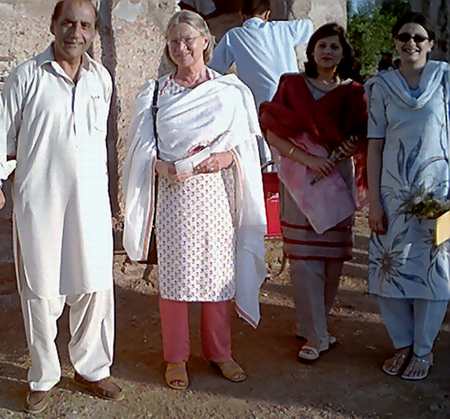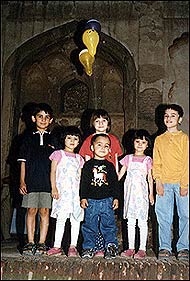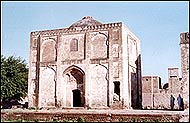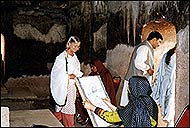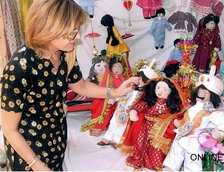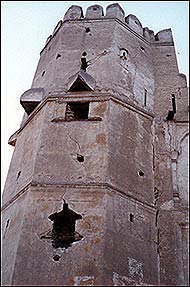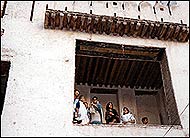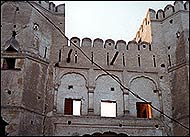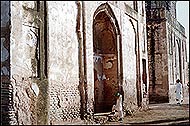The Kotla Mohsin Khan is one of the jewels of Peshawar�s rich cultural and historical heritage, but one that has lost its lustre in recent years. Lack of public awareness and the onslaught of modern developers have wreaked untold damage to many irreplaceable heritage sites. The great western gate to the walled city of Peshawar now stands on unstable ground, its very existence in danger if work is not undertaken to save it soon.
With these concerns in mind, the Sarhad Conservation Network, a local NGO working for the protection of Peshawar�s cultural heritage and natural environment, organized a lively tour and display of the Kotla Mohsin Khan in Peshawar on Sunday 20th April 2003. After a week of angry clouds and incessant rain, a crisp and bright afternoon welcomed the guests. Row upon row of traditional charpoys adorned with silk cushions gave the venue a festive look. Visitors were shown around the site by the host Arbab Haleem Muhammed, designer Tariq Jabbar, writer Imran Rashid Imran, and other local notables. The participants climbed the splendid gateway and, against the backdrop of a mellow sunset, were treated to a breathtaking view of the Peshawar valley surrounded by majestic hills. Response to this glorious scene was superb. One foreign visitor remarked, "I am lucky to be here. I have never before witnessed such a beautiful view of Peshawar and its surrounding hills. It�s a shame that such important places exist in Peshawar but so few are aware of them." Zahid Ilahi, a young innovative expert on development, showed a determination beyond enjoyment, "I am here to show my solidarity for the cause of conservation".
Kotla Mohsin Khan was constructed in the mid 16th century, and today consists of two domed tombs and the famous majestic gateway through which, historically, invaders would enter the walled city. As recently as the 1970s the remains of the rest of the kotla, or fortified residence, was present but ignorance and neglect has left today�s site with only the gateway and tombs. Although not built by the Mughals themselves, the architecture is inspired by their style, predominant when the buildings were designed.
As well as rich architectural value, the site has strong historical significance. The gate and minarets (the latter constructed by Allah Dad Doshshani from which to conduct judicial duties) of Kotla Mohsin Khan are historical landmarks of the Roshnai period. Arbab Mustajab Khan, representative of the Moghuls, settled disputes amongst the Ghori Khel tribes from the gate�s vaulted balconies, and it was also from here that Bayazid Ansari, also known as Pir Rokhan, started his religious and political movement against the Moghul emperor Akbar. Eventually, Rangila Shah�s governor, Nawab Nasir Khan, welcomed the Afghan King Nadir Shah and presented him with the key to Peshawar in 1741, ending Mughal rule of the area. During the more recent siege of Peshawar in 1830s the Sikhs even torched the site, though it was later refurbished.
The two tombs consist of a square podium and an almost-square structure sitting below impressive domes which span the whole of the mausoleum building. Delicate but faded patterns can be detected on the limestone plaster surface, suggesting that once these mausoleums were covered in Muslim surface decoration that natural and human elements have eroded over the years. Floods and salt water have played havoc with the structures, and the lower storey has partially corroded. The gateway itself is a unique example of blending the Mughal style with indigenous architecture found in frontier�s tribal territories to this date.
As the main gate to the walled city of Peshawar, the importance of defending this point motivated its impregnable design. Two looming watchtowers flank the body of the gate, soaring four stories up and replete with gun slits and parapet walls to accommodate medieval sharp shooters, fortifying the citadel and protecting defenders. The lower story makes an imposing sight with an enormous central arch with false arches to either side and above, decorated with Mughal fretwork.
Though still impressive, the state of the gate building today betrays its construction as a powerful defensive structure, and stands in critical condition. Vertical cracks on both sides of the tower suggest that soil settlement is aggravating the condition of the gates and arches. Saleem Khattak, a UNESCO consultant for a walled city conservation project, believes efforts should be directed immediately to arrest this threatening subsistence before it is too late. This fantastic and intimidating site is the only remaining monument to the Roshnai movement against the Mughals � and it is facing oblivion.
Efforts have been made in the past to preserve the buildings. The gates themselves were supposedly conserved at a cost of over Rs 8 million by the Peshawar Management Department, a provincial organisation created by the PPP government. According to Saleem Khattak, instead of restoring the gates� original character, they disfigured the unique design and mutilated the Mughal patterns, particularly the upper and middle arches of the main gate. Other parts escaped this onslaught, and therefore still retain some traces of the original surface decorative patterns and original structure.
The tour and awareness day was a very refreshing activity in the otherwise drab local cultural scene in Peshawar. Materialism overtook concerns like conservation and heritage at the beginning of the 1980s, and one historical building after another has come under the axe of developers and construction mafias, turning Peshawar into a modern graveyard of concrete monstrosities. The SCN has been trying to work against this attitude to historical buildings, so wanted to bring as many people as they could to enjoy the splendour of the Kotla Mohsin Khan. It seemed as though they succeeded. Many families were present, which was a nice confirmation of the public concern for heritage, an apparent congratulation to the SCN and its efforts. Children were entertained with balloons, traditional music enriched the colourful event, and rounds of tea and refreshments were served continuously.
Importantly, from the point of view of heritage development, local people looked pleased to see so many newcomers in their midst taking keen interest in the site, which they feel has been neglected for far too long. Hopefully, new numbers of enthusiastic visitors will create more awareness and sensitivity for their prized possession, and prevent it from falling to the developers like other precious sites have in recent years. One man, Arbab Haleem, explained the importance of keeping local people involved in the site�s preservation: "Although a lot has been written about the significance of the site, the most accurate information can only be provided by the local inhabitants. Our family has preserved ancient documents, which give a number of clues and point to a wealth of information about the historical importance of Kotla Mohsin Khan."
Dr Murad Ali, the executive director of the SCN, brimmed with pleasure at the success of the event. "SCN will arrange more events like these to highlight the cause of conservation and to create awareness of the topic. We plan to make every effort to conserve and preserve our regional and national cultural heritage," he stressed. He appealed to the authorities and citizens of Peshawar to take a more pro-active role for conservation of the walled city of Peshawar.
It is to be hoped that the success of the Kotla Mohsin Khan awareness day run by the SCN will continue as more of Pakistan�s cultural sites are preserved and restored. In Peshawar at least, there is continuing investment in the protection of its historical treasures. Lately, UNESCO has undertaken the task of conserving the walled city of Peshawar in collaboration with the NWFP government and has identified several more heritage sites. In fact the governor is taking a personal interest in the conservation of Peshawar�s heritage, which is a welcome sign. Also, the director of archaeology and museums, along with his talented team, is contributing to this gigantic enterprise, and hopefully work will start soon on several buildings and sites of the old city. All this is encouraging - after all, there is more to enjoy at the stunning monuments to Pakistan�s history than restoration. Mrs Gulminah Majeed Khan, talking at the Kotla Mohsin Kahn, expressed sheer delight at being there, "It�s a wonderful experience to be at the heart of an ancient city - so peaceful and intoxicating!"
May 16 - 22, 2003 - Vol. XV, No. 12 |
